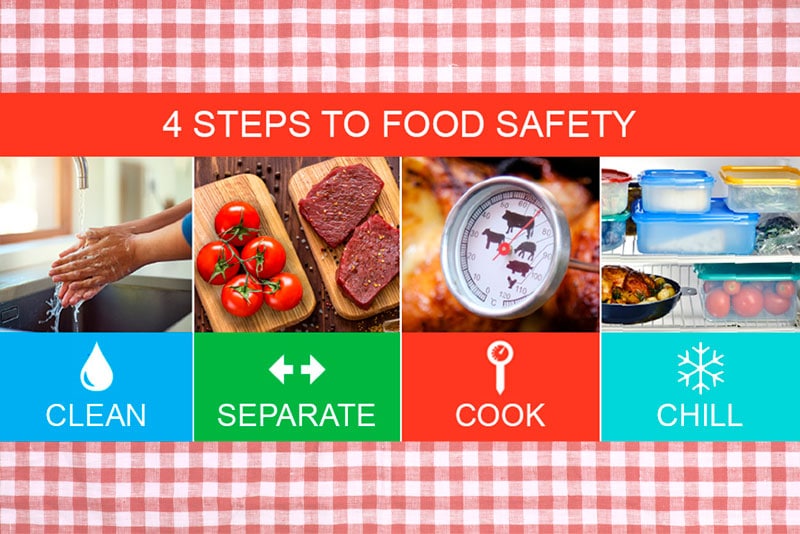Summer Food Safety: Facts and Best Practices

Here are four proven steps to help keep you and your family safe from food poisoning this summer
Why food safety matters to you
The Center for Disease Control and Prevention (CDC) estimates that one in six Americans (48 million people) become sick from food poisoning each year. These incidents send 128,000 Americans to the hospital, and an estimated 3,000 die annually from foodborne illnesses.
Food safety is especially important as we approach Memorial Day weekend. This weekend traditionally marks the beginning of summer activities, many of which will involve preparing and serving food for family and friends.
Unfortunately, the summer months coincide with a rise in the rates of foodborne illnesses. This increase undoubtedly occurs because germs grow faster in warmer, more humid weather.
Germs can survive in many places, including your kitchen. Germs can also stay on your food, hands, utensils, cutting boards, countertops, outdoor tables, and grills. Ingesting food contaminated with these germs can make you sick.
The Moultrie County Health Department (MCHD) joins the CDC and the Illinois Department of Public Health in reminding you to Clean, Separate, Cook, and Chill as part of your food safety plan. Below are basic recommendations for implementing these four steps:
Clean: Wash hands and surfaces frequently
- The germs that cause food poisoning can spread around the kitchen and survive in many places.
- Wash your hands for 20 seconds with soap and water. Wash before, during, and after preparing food and before eating.
- After preparing each food item, wash your cutting boards, utensils, and countertops with hot, soapy water. This action is essential to food safety when preparing raw meat, poultry, and seafood.
- Rinse fresh fruits and vegetables under running water.
Separate: Don’t cross-contaminate
- Raw meat, poultry, seafood, and eggs can spread germs to ready-to-eat foods.
- Use separate cutting boards and plates for raw meat, poultry, and seafood.
- Keep raw meat, poultry, seafood, and juices away from other foods when grocery shopping.
- Keep raw meat, poultry, seafood, and eggs separate from other foods in the refrigerator.
Cook to the right temperature
- In addition to clean surfaces and food products, cooking foods thoroughly to a temperature high enough to kill germs, and keeping foods at a safe temperature while serving them are two of the best ways to ensure the food you are providing is safe.
- Use a food thermometer to confirm you’ve cooked your foods to a safe internal temperature. Download this chart for a detailed list of cooking temperatures for various foods, including shellfish and precooked ham.
- Whole cuts of beef, veal, lamb, and pork, including fresh ham (raw): 145°F (then allow the meat to rest for 3 minutes before carving or eating)
- Fish with fins: 145°F or cook until flesh is opaque
- Ground meats, such as beef and pork: 160°F
- All poultry, including ground chicken and turkey: 165°F
- Leftovers and casseroles: 165°F
- Microwave food thoroughly:
- Know your microwave’s wattage. Check inside the door, owner’s manual, or manufacturer’s website. Lower wattage means longer cooking time.
- Follow recommended cooking and standing times to allow additional cooking after microwaving stops. After microwaving, letting food sit for a few minutes allows cold spots to absorb heat from hotter areas and cook more completely.
- When reheating, use a food thermometer to ensure that microwaved food reaches 165°F.
- When serving food, it is best to keep hot foods above 140°F, and cold foods chilled at 40°F or below. You can maintain these temperatures by using a slow cooker or a hot roaster, or thermal coolers to keep hot foods hot. Prechilling cold foods in the refrigerator and keeping them in ice packs or coolers filled with ice will help keep cold foods cold.
Chill: Refrigerate promptly
- Bacteria can rapidly multiply if left at room temperature or in the “Danger Zone” between 40°F and 140°F.
- Keep your refrigerator at 40°F or below and your freezer at or below 0˚F. You can download this chart to help you know when to throw food away.
- Divide warm foods into several clean, shallow containers so they will chill faster.
- Refrigerate perishable food within two hours. Refrigerate within one hour if exposed to temperatures above 90°F (like a hot car or picnic).
- Thaw frozen food safely in the refrigerator, in cold water, or using a time defrost on your microwave. Never thaw foods on the counter because bacteria multiply quickly in the parts of the food that reach and stay at room temperature longer.
Food Safety: More Information Available
We hope you find this information helpful as you begin your summer celebrations. However, please remember that these food safety practices are appropriate throughout the year.
For more detailed information, please see the content sources below:
Centers for Disease Control and Prevention
National Center for Emerging and Zoonotic Infectious Diseases
Division of Foodborne, Waterborne, and Environmental Diseases

